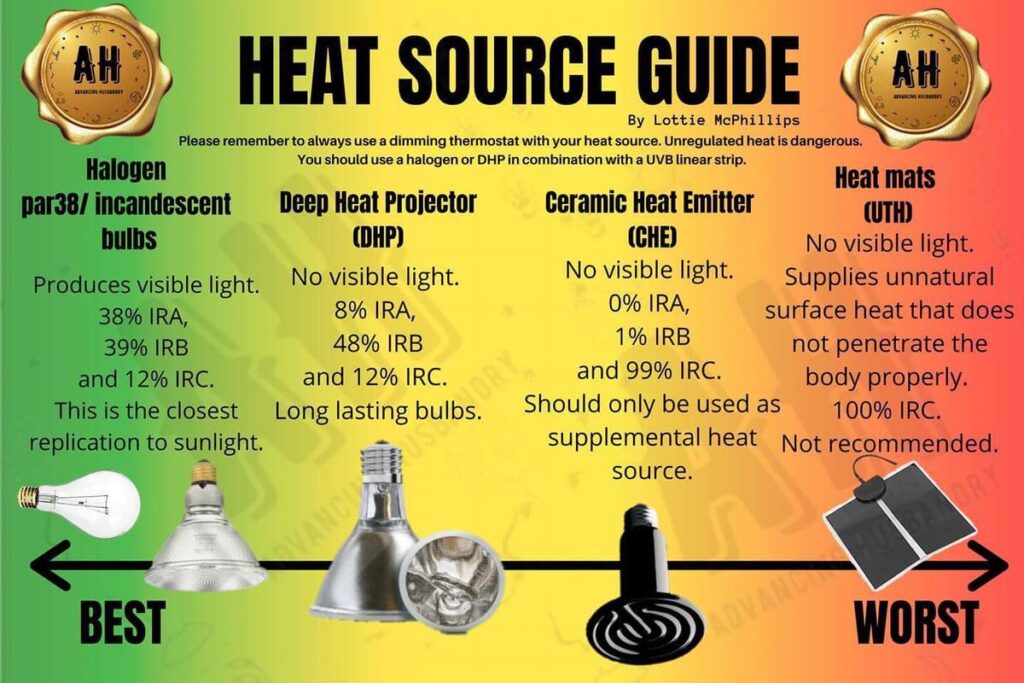The best heating sources for lizards are ceramic heat emitters, heat pads, and heat lamps.
What Is The Best Heat Source For Reptiles?
Overhead heating systems are the most effective for larger enclosures, such as snake setups or lizard setups, and work well to create athermogradient when placed at one end of the animal’s enclosure.
What Heat Do Lizards Need?
Woodland lizards require moderate warmth (75-90oF) and humidity (60-80%). Rainforest lizards require awarm and humid environment between 75-90oF and adaytime basking area. Enclosures should have an ultra-violet light (UV-B), which most diurnal lizards need for vitamin Dsynthesis.
What Is The Main Source Of Lizards Body Heat?
Lizards, like most reptiles, are ectothermic. Ectothermy is the reliance on external heat sources to increase body temperature. Thus lizards gain heat, principally, from their environment.
How To Keep A Lizard Tank Warm?
Good insulating materials that you may have around your home, include: styrofoam, cork panels, polyethylene and bubble wrap. If you don’t have aaccess to any of these items, wrapping your terrarium in blankets and towels will work in apinch.
Do Lizards Prefer Hot Or Cold?
Cold blooded animals are much more active in warm environments and are very sluggish in cold environments. This is because their muscle activity depends on chemical reactions which run quickly when it is hot and slowly when it is cold. This is why we see lizards mostly in summers.
Do Lizards Need Sunlight?
Why do reptiles need UV light?
Ultraviolet (UV) light is necessary for reptiles to manufacture vitamin D3, which is required for the intestines to successfully absorb calcium from food. Diurnal wild reptiles typically spend many hours aday basking in the sun, absorbing this light.
What Is The Lifespan Of A Lizard?
Lizard Lifespan The lifespan of aLizard depends on the species of Lizards. Geckos survive for about 10-15 years in atypical home, the Chameleons are known to survive for around 5-7 years, the Iguanas survive for about 20 years, and the Komodo Dragons, the biggest of the reptiles, live for an average of 40 years .
Can You Overheat A Lizard?
Ectotherms (the name for ectothermic animals like most fish, reptiles, and amphibians) don’t always want or need to be hot to live their lives and can overheat just like mammals like humans can if they can’t escape extreme temperatures.
How Do Lizards Get Warm?
Most reptiles use direct radiant heat from the sun (basking) in combination with conductive heat from sun-heated surfaces such as branches, rocks or other heat accumulating structures to increase their body temperature.
What Makes A Lizard Cold-Blooded?
Because reptiles are ectotherms, they have aslow metabolic rate – as little as 1/7 of the rate of asimilarly sized mammal. They cannot live in very cold conditions – because of this, they are not as widespread as endotherms (e.g., mammals), but have survived and evolved for millions of years.
What To Do If A Lizard Is Cold?
Treating Hypothermia When the reptile is dry, wrap it in awarmed towel and place it on ahuman heating pad in its enclosure or basking area.
Do not provide the species normal basking temperatures at this point!
What Happens If My Lizard Gets Too Cold?
Reptile bodies can freeze completely, leading to death. Chronic hypothermia negatively impacts the reptile’s immune system which can lead to secondary infections. These infections can be life threatening even if the hypothermia is corrected.
How Much Heat Does A Lizard Need?
This will depend on the species. For example, the bearded dragon needs ahot side at 85-100 degrees and 70-85 degrees for the cool side. In addition, they need abasking spot that is 100 degrees. While a leopard gecko needs atank temp of around 80 degrees with abasking spot that is 95 degrees.
How To Make A Lizard Cage Warmer?
Heat lamps are usually best for lizards. You can give him something to climb on, so that he can get right up under it, (don’t put it so close that he could burn himself on the top of the enclosure. Feel it, to see if it’s getting too hot).
What Is The Indoor Heat Source For Reptiles?
We recommend ausing an infrared heater as these are the most affective kind of heating – but not to be confused with ‘red’ heat lights. Infrared heaters do not output any light, therefore their heating does not affect the day/night cycle for your reptile or dry out the air in your enclosure.
What Is The Most Efficient Way To Heat A Reptile Tank?
You should probably get ablack light, which is aUV heating lamp, and you could leave it on in the night, keeping the tank warm. Acover tends to help keep in heat as well. You could put both lights on one side of the tank and put athermometer there to measure the difference in heat for different parts of the tank .
Do Lizards Like Dark Or Light?
Lizards like dark places such as inside of cabinets, behind wardrobes and furniture. So, make sure you clean and air out these places regularly.
How Do Lizards Survive At Night?
Nocturnal reptiles, such as the banded gecko, passively exchange heat with the air and soil.
What Do You Feed Lizards?
Offer avariety of foods such as insects (eg, meal worms, snails, slugs, worms), clover, dandelion, mulberry leaves, milk thistle, watercress, chopped fruits and vegetables (such as bananas, apple, pawpaw, pears, green beans, carrots, alfalfa sprouts, parsley and tomato) .
Which Lizard Lives The Longest?
The tuatara, alizard-like reptile native to New Zealand, can live well over 100 years. Henry, atuatara at the Southland Museum in New Zealand, mated for the first time at the estimated age of 111 years in 2009 with an 80-year-old female and fathered 11 baby tuatara.
What Type Of Lizard Has The Shortest Lifespan?
Labord’s chameleons
How Do You Warm Up A Lizard?
Heating/Basking Lamps They’re great for reptiles that love to stretch out under sunlight in their natural environment. Basking and heating lamps use heat bulbs to create aspecific area that concentrates the heat and mimics the effects of your reptile basking in abeam of sunlight.
Do Lizards Like Cold Or Warm?
The most important thing to remember is that reptiles are cold-blooded animals. This is why humid and warm conditions are essential for most species. Reptile species vary, but most require aconstant temperature between 70 to 85°F with basking areas that reach over 100°F.
How Do You Cool Down A Lizard?
Ju st li ke us , Re pt il es ca ng et to ow ar m ! Is it re al ly to ow ar m ?
Th ef ir st th in gy ou ne ed to do is ma ke su re it re al ly is to ow ar m . . . . Fr es hw at er . . . . Fa n . . . . Im pr ov et he ve nt il at io n . . . . Ic ec ub es . . . . Fr oz en wa te rb ot tl e . . . . Co ol ti le . . . . Re du ce th eh ea tc om in gi n .
How Do You Keep Lizards Warm At Night?
This can be done using either aheat lamp, including halogen bulbs or aceramic heat emitter, installed into aceramic bulb holder, both of which should be connected to acompatible high-range thermostat to regulate and maintain aconsistent temperature.
What Happens When A Lizard Gets Too Cold?
Lizards will move back and forth between the sun and shade to keep their bodies around acertain temperature. For most lizards, this temperature is best for digestion, or the processing of food. If they get too cold, they cannot digest food as well, and cannot get as much energy and nutrients out of their meal.
How Do Lizards Cool Themselves?
‘The most common way lizards control their body temperature is by moving back and forth from sunny to shaded sites‘, says Caleb Loughran from the University of New Mexico, USA, explaining that many species seek shade or strike cooling poses to keep their temperatures down.
How Do Reptiles Keep Warm?
cold-blooded animals like reptiles regulate their body temperature by getting their energy by heat and getting into shade when they are too hot.



